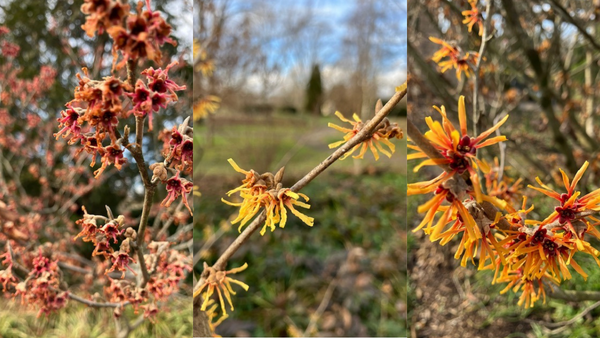Published February 27, 2024
One of America’s Largest Witch Hazel Collections

Witch hazels are flowering plants boasting warm colors that also have medicinal properties. There are four main species – American witch hazel (H. virginiana), Chinese witch hazel (H. mollis), Ozark witch hazel (H. vernalis) and Japanese witch hazel (H. japonica) – and hundreds of cultivars (plant varieties that have been cultivated through selected breeding). These plants can be a variety of different colors and have incredibly fragrant blooms.
Wegerzyn Gardens MetroPark currently has one of the largest witch hazel collections, by number of cultivars, in North America with more than 120 kinds of witch hazel.
The witch hazel collection at Wegerzyn Gardens MetroPark was started by horticulturist Chris Jensen. He first purchased a common, fall blooming witch hazel plant native to the eastern United States. The collection grew from there to include spring blooming plants, rare plants, plants that were only recently discovered and a few variegated plants.
Wegerzyn Gardens MetroPark’s witch hazel collection blooms during the fall and spring. The fall blooming season typically starts at the end of October. If the fall is dry, the witch hazels stop blooming by mid-to-late November. If the fall is wet, the plants will bloom through December, if there continues to be moisture. The spring blooms begin in mid-January as long as there is moisture in the air, or wet weather, and no hard freezes.
Most plants in the collection are tagged and are along the woodland border of the formal gardens. There are also witch hazels spread around the park for you to spot as you wander the property.
There are groups of witch hazel plants at the entry to the Federal Garden, at the end of the English Garden, at the south end of the Victorian Garden and on the slope of the South Plaza. These provide spectacular fall foliar color. In the cold months, the fragrant ones smell best on a sunny, slightly warm day. Many of the spring blooms are yellow. However, the red imp is a unique spring-blooming plant with large, very fragrant, red-orange blooms.
“The best witch hazel plants we have are the one at the bridge leading to the building, the one in the pathway behind the arbor with steppingstones from the arbor lawn to the woodland lawn, several along the woodland walk, and several at the south plaza grouping,” said Betty Hoevel, Five Rivers MetroParks education coordinator.
Wegerzyn’s red imp witch hazel is located at the north end of the gardens by the covered walkway. If you stop underneath the center of the covering and turn right, you’ll see this plant, which blooms in January and February.
An area’s USDA Plant Hardiness Zone, the standard by which gardeners and growers can determine which perennial plants are most likely to thrive at a location, determines the types of witch hazel that can survive there. Ohio is currently considered part of Zone 5 and Zone 6. This means only witch hazels from similar zones will grow here and further highlights how impressive the Wegerzyn Gardens MetroPark’s witch hazel collection is to produce so many different plants.
While witch hazels are typically used for their medicinal properties or flowering decor, they also help our ecosystem.
“One additional benefit of witch hazel, and why people should plant them, is because they bloom in winter and provide nectar for honeybees,” said Ron Schilb, expert of the witch hazel collection at Wegerzyn Gardens for 22 years.
Honeybees and other bee species are just a few of the pollinators that benefit from these plants. Fruit flies, beetles, wasps and beyond all play an important role in our ecosystem and benefit from flowering pollinator plants. Pollinators that overwinter may also rely on flowering plants.
Bees, for example, feed off nectar and the honey they’ve stored in their hives. If they become active during the winter, which is becoming more common with climate change, they use up all their honey too early. If they can’t find enough nectar to make more honey, they die.
“This is especially important as winters are getting warmer. I try to do all I can to promote witch hazels,” said Schilb.
If you want to learn more, witch hazel programs are led in the fall and early spring. Visit metroparks.org/programs to see the full list of offered programs.





